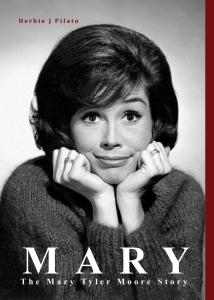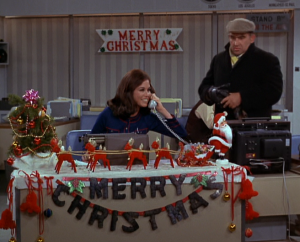A Very “MARY” Christmas!
New Book Fondly Recalls Mary Tyler Moore, Her Sitcom’s 50th Year, and a Special Heartwarming Yuletide Episode
LOS ANGELES, CA, LOS ANGELES, December 22, 2020 /EINPresswire.com/ -- Five decades ago, “The Mary Tyler Moore Show” premiered on television. During that first season, in December 1970, Moore’s most famous character, Mary Richards, was left alone on Christmas Eve. It’s not easy to work on Christmas Eve, much less, by yourself, but that’s what happened to Mary Richards, in the iconic sitcom’s first holiday-themed episode. Debuting December 19, 1970, “Christmas and the Hard-Luck Kid, II” found Mary stuck on the late-night shift, in the deserted newsroom of WJM-TV, Minneapolis.In doing so, “Mary” won our hearts. And you’ll feel that sympathy anew when reading MARY: THE MARY TYLER MOORE STORY, by Herbie J Pilato, published by Jacobs/Brown Press. Moore’s life, contrary to what some may perceive, was not always a bed of roses. The actress faced numerous challenges and hardships, from diabetes, to two divorces, the deaths of her siblings, and the tragic loss of her only child. But she met these heartbreaks with dignity and class, as we would hope. And when she was ready to face the public once more, Moore again charmed the world … “with her smile.”
“Mary’s greatest gift, when it came to performing, was her humility,” said author Herbie J Pilato. “She was confident and smart enough as an actress, and as a human being, to surround herself with an A-list of supporting actors on ‘The Mary Tyler Moore Show.’ She did not define herself as a comedic actress like Lucille Ball, but rather as an actress who did comedy. She knew her strengths as a performer, and one of those strengths was her innate ability to know how to react to the circumstances or situations, or to other characters, to make us laugh. Her wit, charm, femininity, and appearance combined to give her a unique appeal that stood her apart from other actresses, and people in general. She had that ‘it’ factor, and she factored it into a tremendous success.”
In researching his acclaimed biography of Moore, Pilato discovered that the greatest challenge for the actress during the second half of her 60-plus-year career was competing with herself, or at least the beloved roles she created on screen. He noted, “The personas of Laura Petrie on ‘The Dick Van Dyke Show,’ and Mary Richards on ‘The Mary Tyler Moore Show,’ made for characters that were impossibly perfect, and when fans approached Mary Tyler Moore on the street, they would say things like, ‘I wish I was as nice as Mary Richards.’ To which she would reply, with a smile and somewhat ruefully, ‘So do I.’”
Apart from her abilities as an actress and dancer, what Moore did not possess was a comfortable sense of self-worth. “Mary’s greatest weakness was her inability to see how truly beautiful she was as a human being, inside and out,” Pilato said. “One example is her obsession with plastic surgery. It took over her life and, even though she knew it was not always the wisest choice to make, she kept on tinkering with her looks in a very Michael-Jackson-like manner. She didn’t love herself enough to know that everyone else loved her just the way she was.”
Regarding the impact of “The Mary Tyler Moore Show,” Pilato said, “That series did more to help the Women’s Liberation movement than any other TV show at that time, and perhaps any time since. That was not the show’s objective when it debuted in 1970, but that’s how it worked out. As a result of that series, more women moved into the workforce; more women started to realize that they did not require a man or marriage to define them. Discovering their humanity – the essence of their heart and soul, independent of men – is what worked for them, in more ways than one. And, from a creative standpoint, ‘The Mary Tyler Moore Show’ changed the face of television writing. The show introduced a way of presenting more textured characters. For example, Mary Richards was a more defined character on ‘The Mary Tyler Moore Show’ than Laura Petrie was on ‘The Dick Van Dyke Show.’ We knew more about Mary Richard’s quirks, likes, and dislikes than Laura’s. ‘The Dick Van Dyke Show’ was a sophisticated sitcom for its time, but ‘The Mary Tyler Moore Show’ took that sophistication to another level.”
In respect to the first of several Christmas-themed episodes aired on “The Mary Tyler Moore Show,” Pilato observed, “The sound of Mary’s name is reminiscent of ‘Merry Christmas.’ As Mary Richards, or in real life, Mary Tyler Moore brought a great deal of peace, love, and joy – all of which we most desperately need today, and always.”
This Christmas Season, we can all use a generous dose of peace, love, and joy. And “Christmas and the Hard-Luck Kid, II,” so infused with the spirit of the season, offers that boost. You can watch for it on your favorite streaming service or on DVD.
MARY: THE MARY TYLER MOORE STORY by Herbie J Pilato, and published by Jacobs/Brown Press, is available in hardback, softback, and on Kindle.
For more information about this book, or for media outlets to receive a review copy or to interview the author, contact Rebecca Varga at Rebecca.varga@jacobsbrownmediagroup.com.
Rebecca Varga
Jacobs/Brown Media Group
jacobsbrownpress@gmail.com



